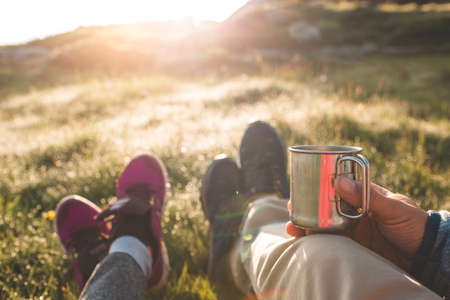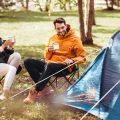1. Choosing the Perfect Route
Spring is one of the best times to hit the road and explore America’s great outdoors. As flowers bloom and temperatures rise, it’s a perfect season for camping road trips. But before you pack your tent and sleeping bag, choosing the right route can make or break your adventure. Here are some iconic and lesser-known American road trip routes that are ideal for spring camping.
Scenic Byways Worth Exploring
The U.S. is filled with scenic byways that offer breathtaking views, charming small towns, and access to great campgrounds. These routes are especially beautiful in spring when nature comes alive.
| Route | Location | Highlights |
|---|---|---|
| Blue Ridge Parkway | Virginia to North Carolina | Mountain views, wildflowers, Great Smoky Mountains NP access |
| Pacific Coast Highway (Highway 1) | California | Coastal cliffs, redwoods, beachside campgrounds |
| Great River Road | Along the Mississippi River | Historic towns, river views, forested campsites |
National Parks Road Trips for Spring Camping
If you want a mix of adventure and natural beauty, planning your route around national parks can be an unforgettable experience. Many national parks open up fully during spring and have fewer crowds than summer.
Recommended National Park Routes:
- Utahs Mighty 5: Arches, Canyonlands, Capitol Reef, Bryce Canyon, and Zion all within driving distance—ideal for desert landscapes and stargazing.
- Sierra Nevada Loop: Yosemite, Sequoia, and Kings Canyon—enjoy waterfalls at their peak flow in spring.
- Northern Arizona & Southern Utah: Grand Canyon, Monument Valley, and Lake Powell—perfect mix of iconic scenery and peaceful campgrounds.
Lesser-Known Gems for Off-the-Beaten-Path Explorers
If youre looking to avoid crowded sites and discover hidden treasures, consider these underrated routes:
| Route Name | Region | Main Attractions |
|---|---|---|
| The Loneliest Road (U.S. Route 50) | Nevada | Quiet landscapes, ghost towns, wide-open skies for camping |
| The San Juan Skyway | Colorado | Snow-capped peaks, alpine lakes, historic mining towns |
| The Cascade Loop | Washington State | Lush forests, mountain passes, waterfalls perfect for spring hikes and campsites |
Pro Tip:
No matter which route you choose, always check weather forecasts and campground availability ahead of time. Spring weather can be unpredictable in some regions!
A well-planned route sets the tone for an unforgettable spring camping trip. Whether you’re chasing mountain vistas or coastal breezes, there’s a perfect road waiting for you out there.
2. Must-Visit Campsites and Scenic Stops
Spring is the perfect time to hit the road and explore some of America’s most beautiful and lesser-known camping spots. Whether you’re driving along the Pacific Coast or winding through the Southwest desert, there are countless campsites and scenic stops worth adding to your itinerary. Here are some popular and off-the-beaten-path destinations to consider for your spring camping road trip.
🌲 Forested Campgrounds
If you love towering trees, cool breezes, and peaceful trails, check out these forested gems:
| Campground | Location | Why Visit |
|---|---|---|
| Jedediah Smith Redwoods State Park | Northern California | Home to ancient redwoods and riverfront sites; great for hiking and kayaking. |
| Great Smoky Mountains National Park | Tennessee/North Carolina | One of the most biodiverse parks in the U.S.; waterfalls, wildlife, and epic mountain views. |
| Olympic National Forest – Hoh Rainforest Campground | Washington | Lush rainforest vibes with moss-draped trees; perfect for a peaceful escape. |
🏜️ Desert Oases & Unique Landscapes
Prefer sunshine, wide-open skies, and surreal rock formations? These desert destinations are sure to impress:
| Campground | Location | Why Visit |
|---|---|---|
| Joshua Tree National Park – Hidden Valley Campground | California | Boulders, cacti, and starry nights—ideal for climbers and stargazers. |
| Canyonlands National Park – Willow Flat Campground | Utah | A remote spot with jaw-dropping canyon views; close to Island in the Sky overlook. |
| Anza-Borrego Desert State Park – Borrego Palm Canyon Campground | California | Great wildflower blooms in spring; palm oasis hike nearby. |
🚗 Scenic Stops Worth Pulling Over For
Pacific Coast Highway (California)
This iconic route offers ocean cliffs, charming beach towns like Big Sur, and stunning sunset pullouts. Don’t miss McWay Falls inside Julia Pfeiffer Burns State Park.
Blue Ridge Parkway (North Carolina to Virginia)
A slow-paced drive through rolling mountains with overlooks that burst into color during spring. Great for picnics and photos.
Moki Dugway (Utah)
A gravel switchback road carved into a cliffside with breathtaking views of Valley of the Gods. It’s a hidden gem for adventurous drivers.
Tip:
If youre going off-grid or visiting remote areas, always check campground availability ahead of time and carry extra water, especially in desert regions.
No matter your route, mixing well-known national parks with lesser-known state parks or BLM land can give you a more varied and memorable experience on your spring camping adventure.

3. Packing Smart for Spring Weather
Spring is a beautiful time to hit the road and explore the great outdoors, but it also means dealing with unpredictable weather. From sudden rain showers to chilly mornings and warm afternoons, being prepared is key to a successful spring camping road trip. Here’s how to pack smart so you can stay comfortable no matter what Mother Nature throws your way.
Layering Is Your Best Friend
One of the best ways to handle changing spring temperatures is by dressing in layers. This lets you add or remove clothing as needed throughout the day. Heres a simple breakdown of essential layers to pack:
| Layer | Purpose | Examples |
|---|---|---|
| Base Layer | Keeps moisture away from skin | Moisture-wicking t-shirts, thermal underwear |
| Mid Layer | Provides insulation and warmth | Fleece pullover, lightweight insulated jacket |
| Outer Layer | Protects against wind and rain | Waterproof shell jacket, windbreaker |
Weather-Ready Camping Gear Checklist
Your gear should be just as adaptable as your clothing. Here are some must-haves for springtime camping:
- Four-season tent or waterproof tent cover: Keeps you dry during unexpected rain.
- Sleeping bag rated for cooler temps: Spring nights can still get cold.
- Ground tarp or footprint: Prevents moisture from seeping into your tent.
- Campsite lighting: Headlamps and lanterns for shorter daylight hours.
- Portable stove and fuel: Cooking over a fire may not always be possible due to wet conditions.
- Poncho or rain gear: Essential for staying dry on hikes or while setting up camp.
Don’t Forget These Road Trip Essentials
A successful spring road trip isn’t just about what you bring for the campsite—it’s also about what’s in your vehicle. Make sure to pack these essentials before hitting the road:
- Emergency kit: Jumper cables, flashlight, first-aid supplies, and basic tools.
- Maps or offline navigation app: Cell service can be spotty in remote areas.
- Snacks and plenty of water: Stay fueled during long drives between stops.
- Towels and quick-dry cloths: Perfect for unexpected messes or damp gear.
- Sunscreen and bug spray: Yes, even in spring!
Pro Tip:
Use storage bins or labeled duffel bags to organize your gear inside your vehicle. That way, you won’t have to unpack everything just to find your raincoat when clouds start rolling in.
The Bottom Line on Packing Smart
Packing smart for a spring camping road trip means planning ahead for all types of weather and keeping comfort top of mind. With the right layers, weather-ready gear, and a few road trip essentials, youll be ready for whatever adventure comes your way this season.
4. Food, Fuel, and Logistics on the Road
When youre hitting the road for a spring camping adventure, staying fueled—both for yourself and your vehicle—is just as important as choosing the right route or campsite. Here are some practical tips to help you stay organized, well-fed, and powered up throughout your journey.
Plan Your Meals Ahead of Time
Meal planning helps reduce waste, saves time at camp, and ensures you have all the ingredients you need. Consider prepping meals before your trip so you can spend less time cooking and more time enjoying nature. Think one-pot meals, pre-made sandwiches, and snacks that don’t require refrigeration.
Sample 3-Day Camping Meal Plan
| Day | Breakfast | Lunch | Dinner | Snacks |
|---|---|---|---|---|
| Day 1 | Granola & Yogurt | Turkey Wraps | Chili & Cornbread | Trail Mix, Apples |
| Day 2 | Pancakes & Bacon | Pasta Salad | Burgers & Veggies | Jerky, Grapes |
| Day 3 | Oatmeal with Fruit | PB&J Sandwiches | Taco Bowls | Nuts, Energy Bars |
Fuel Up Smartly
If youre driving through rural areas or national parks, gas stations can be few and far between. Always top off your tank when you’re near a town or highway exit. Consider using apps like GasBuddy to find the best prices and locations along your route.
Fuel Tips:
- Never let your tank drop below a quarter full in remote areas.
- Keep a small gas can (safely stored) if youre heading off-grid.
- Add fuel stops into your itinerary during trip planning.
Keep Devices Charged
Your phone is your GPS, camera, emergency contact tool—and maybe even your entertainment. Keeping it charged is key. Bring portable power banks and consider a solar charger for longer trips. A car power inverter can also let you plug in larger devices while driving.
Charging Essentials Checklist:
- Multiple USB cables (plus extras)
- Portable battery packs (charged beforehand)
- Solar charger or power station for extended stays
- Lighter socket USB adapter for charging while driving
Organize Your Vehicle Like a Pro
A cluttered car can make road tripping feel chaotic fast. Use bins, seat organizers, or rooftop storage to keep things accessible yet tidy. Group items by category—food in one bin, cooking gear in another, clothes in duffel bags—and label everything so you know where to reach without digging around.
Vehicle Organization Tips:
- Cargo bins: Use stackable plastic containers to separate supplies.
- Shoe organizers: Hang over seatbacks to store smaller items like sunscreen or utensils.
- Cooler placement: Keep it within reach for quick snack stops.
- Pillow & blanket bag: Roll soft items together to save space and double as backrest cushions.
A little planning goes a long way when it comes to food, fuel, and logistics on the road. With these simple strategies, youll be ready to enjoy every mile of your spring camping road trip with less stress and more fun!
5. Staying Safe and Eco-Friendly
When youre out on a spring camping road trip, its not just about the places you visit—its also about how you treat those places. Keeping your journey safe and eco-conscious makes the experience better for you, fellow travelers, and nature itself. Heres how to camp responsibly and stay safe along the way.
Leave No Trace: The Basics
The Leave No Trace principles are guidelines to help minimize your impact on the outdoors. Following these helps protect natural spaces for future visitors and wildlife.
| Principle | What It Means |
|---|---|
| Plan Ahead and Prepare | Know where youre going, check weather forecasts, and bring proper gear. |
| Travel and Camp on Durable Surfaces | Stick to established trails and campsites to avoid damaging plants and soil. |
| Dispose of Waste Properly | Pack out all trash, leftover food, and litter—even biodegradable items. |
| Leave What You Find | Don’t pick flowers or take rocks—leave nature as you found it. |
| Minimize Campfire Impact | Use a camp stove if possible; if fires are allowed, keep them small and use fire rings. |
| Respect Wildlife | Observe animals from a distance; never feed them or leave food out. |
| Be Considerate of Others | Keep noise down, yield on trails, and respect other campers’ space. |
Wildlife Safety Tips
Spring is an active season for wildlife. Here’s how to stay safe while sharing the outdoors with animals:
- Store food properly: Use bear-proof containers or hang food when in bear country.
- Avoid surprise encounters: Make noise while hiking to alert animals of your presence.
- Keep a safe distance: Use binoculars or zoom lenses instead of approaching wildlife.
- No feeding: Feeding animals can make them dependent or aggressive toward humans.
Respectful Recreation
Campsites, trails, and parks are shared spaces. Practicing respectful recreation ensures everyone has a good experience. Be mindful by:
- Following posted rules: Check signs at trailheads and campgrounds for local guidelines.
- Packing out pet waste: If traveling with pets, clean up after them just like you would in your neighborhood park.
- Avoiding loud music: Let nature’s sounds be the soundtrack of your trip.
Sustainable Travel Choices
You can reduce your environmental footprint with some simple planning:
- Carpool or drive fuel-efficient vehicles: Fewer cars mean less emissions and traffic at popular sites.
- Bring reusable gear: Water bottles, utensils, and containers cut down on single-use plastics.
- Support local businesses: Buy supplies from towns near campgrounds to support the local economy.
Your Role in Preserving the Outdoors
Your actions matter. By staying safe, respecting wildlife, following Leave No Trace principles, and being mindful of others, youre helping protect these beautiful places for everyone who comes after you.


